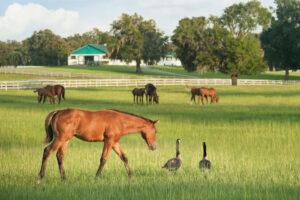WNV in Ohio Horses: Five More Cases Confirmed

On Oct. 16 the Equine Disease Communication Center (EDCC) reported that the Ohio Department of Agriculture (ODA) has confirmed five more cases of equine West Nile virus (WNV). According to EDCC data, officials have now confirmed 43 cases of WNV in Ohio horses so far this year—more than triple the number of cases confirmed last year.
According to the EDCC and ODA:
- A 6-year-old Standardbred mare from Trumbull County developed clinical signs on Sept. 19; the owner called the veterinarian regarding a neurologic horse that was wobbly. Despite treatment, the next evening the mare became recumbent (down and unable to rise) and the owner elected euthanasia. A serum sample submitted to the National Veterinary Services Laboratory (NVSL) had an IgM capture ELISA titer of 1:400 or greater, suggesting recent WNV exposure. The horse was not vaccinated against WNV.
- An adult Standardbred gelding from Holmes County developed clinical signs on Sept. 22; the owner called the veterinarian when, after driving the horse, he noticed the gelding had weak hind limbs, was pulling to the right, and dragging his hoofs. The veterinarian found the horse was agitated and had muscle fasciculations (involuntary twitching) and began treatment immediately. A serum sample submitted to NVSL had an IgM capture ELISA titer of 1:400 or greater, suggesting recent WNV exposure. The horse was not vaccinated against WNV. As of Sept. 24, the horse was reported to be alive and recovering.
- A 4-year-old Friesian gelding from Holmes County began exhibiting clinical signs on Sept. 21; the owner called the veterinarian to report that the horse wasn’t eating, was refusing to move, and had muscle fasciculations. The horse was vaccinated against WNV one week prior to showing clinical signs. A serum sample submitted to NVSL had an IgM capture ELISA titer of 1:400 or greater, suggesting recent WNV exposure. As of Sept. 24, the horse was reported to be alive and recovering.
- An adult Standardbred from Geauga County developed clinical signs on Sept. 24. The owner called the veterinarian after noticing the horse had stiff limbs and had stopped eating. The veterinarian responded, treated the horse, and left medication for the owner to administer. A serum sample submitted to NVSL had an IgM capture ELISA titer of 1:400 or greater, suggesting recent WNV exposure. The horse was not vaccinated against WNV. As of Sept. 24, the horse was reported to be alive and recovering.
- An adult Standardbred gelding from Ashtabula County began exhibiting clinical signs on Sept. 29; his owner called the veterinarian after finding him wobbly and having difficulty standing. The veterinarian responded and treated the horse. A serum sample submitted to NVSL had an IgM capture ELISA titer of 1:400 or greater, suggesting recent WNV exposure. The horse was not vaccinated against WNV. As of Sept. 29, the horse was reported to be alive and recovering.
In 2017, officials confirmed 14 cases of WNV in Ohio horses, according to USDA Animal and Plant Health Inspection Service data
Create a free account with TheHorse.com to view this content.
TheHorse.com is home to thousands of free articles about horse health care. In order to access some of our exclusive free content, you must be signed into TheHorse.com.
Start your free account today!
Already have an account?
and continue reading.

Related Articles
Stay on top of the most recent Horse Health news with















